

The Best Interactive Web Tools for Educators. Most of us are working at full capacity, and keeping up with technology can feel like one more chore on the to-do list. Still, learning your way around a few of the best Web tools is worth your time. Innovative teachers are frequently using intuitive programs and websites that are easy to learn. These web tool can save you a lot of daily hassles that you might not even realize you have been tolerating. Whether you want to move the class newsletter online or try out a flipped classroom, we’re sharing the best sites to do it. 5 Ways to Add Interactive Elements to Your Videos. Over the last few days I've featured a couple of free tools for adding interactive elements to your videos.

In the last year I've reviewed a few other services and methods for doing the same thing. This is a round-up of the ways that you can add interactive elements to your videos. The first four tools could be used by students to create a series of choose your own adventure videos. These tools could be used by teachers to enhance the short videos that they create for flipped lessons. YouTube has annotation tools built right into the editor that you can use when you upload your own content to the site. Logo and Graphics Generator - Cool Text.
17 Tips To Motivate Adult Learners. The introduction of learning technology and the changing workplace recently increased the importance of adult learning.
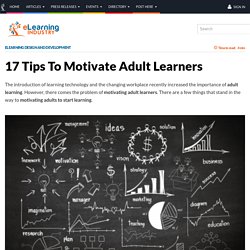
However, there comes the problem of motivating adult learners. There are a few things that stand in the way to motivating adults to start learning. How To Motivate Adult Learners Adults, unlike children, teenagers and students, in most cases, have a lot of things on their minds and your eLearning course is probably the last one of them. In addition, your adult learners don't see the rewards of their efforts as soon as they would expect, and giving them candy doesn't work as it works with children. Chapter3. Beyond the Discussion Board - 10 Tips for Engaging Online Students.
Untitled. eLearning Infographics - The No.1 Source for the Best Education Infographics. Interactive Infographic - 13 Reasons Why Your Brain Craves Infographics. Motivating Students. Introduction Fostering student motivation is a difficult but necessary aspect of teaching that instructors must consider.

Many may have led classes where students are engaged, motivated, and excited to learn, but have also led classes where students are distracted, disinterested, and reluctant to engage—and, probably, have led classes that are a mix. 20 Questions To Guide Inquiry-Based Learning. 20 Questions To Guide Inquiry-Based Learning Recently we took at look at the phases of inquiry-based learning through a framework, and even apps that were conducive to inquiry-based learning on the iPad.
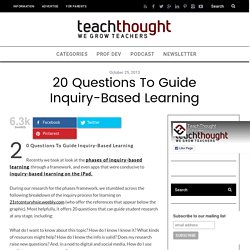
During our research for the phases framework, we stumbled across the following breakdown of the inquiry process for learning on 21stcenturyhsie.weebly.com (who offer the references that appear below the graphic). Most helpfully, it offers 20 questions that can guide student research at any stage, including: What do I want to know about this topic? How do I know I know it? Top 10 Free Content Curation Tools For Teachers. Daily Infographic. Malcolm Knowles, informal adult education, self-direction and andragogy. Contents: introduction · malcolm knowles – life · adult informal education · malcolm s. knowles on andragogy · self-direction · conclusion · further reading and references · links Malcolm Shepherd Knowles (1913 – 1997) was a, perhaps ‘the’, central figure in US adult education in the second half of the twentieth century.
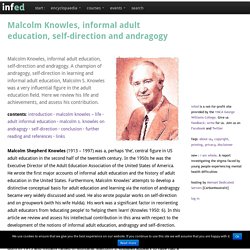
In the 1950s he was the Executive Director of the Adult Education Association of the United States of America. He wrote the first major accounts of informal adult education and the history of adult education in the United States. Furthermore, Malcolm Knowles’ attempts to develop a distinctive conceptual basis for adult education and learning via the notion of andragogy became very widely discussed and used.
Bloom's and ICT tools. Many teachers use Bloom's Taxonomy and Bloom's Revised Taxonomy in developing and structuring their teaching & learning experiences.

Bloom's Digital taxonomy is an attempt to marry Bloom's revised taxonomy and the key verbs to digital approaches and tools. This is not a replacements to the verbs in the revised taxonomy, rather it suppliments and supports these by including recent developments, processes and tools. This page looks at some specific examples of tools and match them to Bloom's Digital Taxonomy Many of these tools that are FOSS (Free or Open Source Software). These are in italics. Some tools are marked with abbreviations as they cover a variety of tools.Main pageTraditional and Digital approaches Benjamin Bloom developed, in the 1956 while working at the University of Chicago, developed his theory on Educational Objectives. Goals, Objectives and Outcomes › Assessment Primer › Assessment › University of Connecticut.
Outcomes Pyramid The assessment literature is full of terminology such as “mission”, “goals”, “objectives”, “outcomes”, etc. but lacking in a consensus on a precise meaning of each of these terms.

Part of the difficulty stems from changes in approaches to education – shifts from objective-based, to competency-based, to outcomes-based, etc. education have taken place over the years with various champions of each espousing the benefits of using a different point of view. Instructional Design. Developing Course Objectives Objectives describe what learners will be able to do at the end of instruction, and they provide clear reasons for teaching.
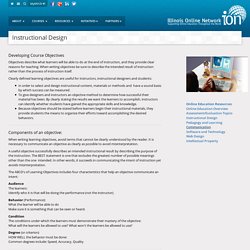
When writing objectives be sure to describe the intended result of instruction rather than the process of instruction itself. Clearly defined learning objectives are useful for instructors, instructional designers and students: In order to select and design instructional content, materials or methods and have a sound basis by which success can be measured. To give designers and instructors an objective method to determine how successful their material has been. Learning Objectives. Before you decide on the content to cover in your course, endow your course with a strong internal structure conducive to student learning.
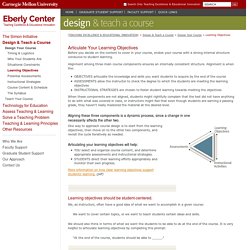
Alignment among three main course components ensures an internally consistent structure. Alignment is when the: OBJECTIVES articulate the knowledge and skills you want students to acquire by the end of the courseASSESSMENTS allow the instructor to check the degree to which the students are meeting the learning objectivesINSTRUCTIONAL STRATEGIES are chosen to foster student learning towards meeting the objectives When these components are not aligned, students might rightfully complain that the test did not have anything to do with what was covered in class, or instructors might feel that even though students are earning a passing grade, they haven’t really mastered the material at the desired level. Bloom’s Taxonomy Verb List. Teaching critical thinking using Bloom’s Taxonomy. In her previous post for Cambridge Conversations, Unlock author Carolyn Westbrook introduced the basics of teaching Critical Thinking in ELT.
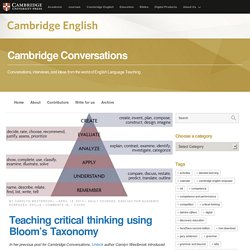
Today, she explores Bloom’s Taxonomy. Bloom’s Taxonomy of Learning Objectives classifies a number of skills which can be used to teach critical thinking. The six skills are often depicted as a triangle, as above. However, representing the skills like this gives the impression of a hierarchical approach to critical thinking. It seems to suggest that the Lower Order Thinking Skills (remember, understand and apply) must be acquired before the Higher Order Thinking Skills (analyze, evaluate and create) can be learnt. Eng 389, Emory University, Spring 2014. Course Description MWF 10:00-10:50 | Callaway Center S109 | Prof. Brian Croxall In many ways, humanities scholarship is already digital: whether you’re working on Chaucer or Chabon, most of us do our research, writing, and sometimes reading at a computer.
In these situations, the computer replaces the index, the pen, and the printed book. In a sense, then, the computer has simply sped up processes with which humanists were already familiar. 8 Keys to the Mindset of a Successful eLearning Professional. Whether you are just getting started with eLearning and looking to get a better understanding of eLearning best practices, or you've been creating courses for a while and are trying to find ways of making your material more effective, considering the basics of eLearning is key. Before you start designing or re-designing be sure you put first things first. And that means getting into an eLearning mindset. It is very important for every eLearning professional seeking success to continuously work on their mindset. eLearning 101: 10 Must-Reads Before Creating Your First Course. New to eLearning course development? Never built a course before? You don’t have any formal background in designing educational materials and interfaces?
How-to ‘Retrofit’ an Online Course. Without continual growth and progress, such words as improvement, achievement, and success have no meaning. Benjamin Franklin If you’ve ever been a homeowner you know about improvement projects – the endless list of items that need fixing, painting or restoring.